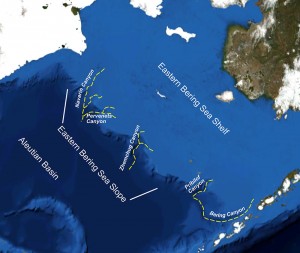
Submarine canyons run through the Bering Sea. The Pribilof, Zhemchug, and Pervenet canyons (and others) cut deep into the continental shelf and are some of the largest in the world.
Canyons influence ocean currents and upwelling conditions; they serve as habitat and fishing grounds; and, unfortunately, we don’t know as much about them as we should.
Significant scientific questions remain unanswered, causing submarine canyon policy to suffer from information gaps.
The Marine Conservation Alliance works to ensure that there is seafood to feed the world. We partner with the National Marine Fisheries Service in cooperative research activities like remote sensing technology and documenting fishermen’s knowledge. Better information means better management of these impressive geological features.
- In the summer of 2014, the Alaska Fisheries Science Center conducted a camera drop survey of the Bering Sea shelf break and continental slope areas to assess the abundance of deep sea coral, sponge, and sea whips. MCA compiled a brief summary describing the findings of the Bering Sea research on deep sea coral. You can read the full summary by clicking here.
- In response to the North Pacific Fishery Management Council’s (NPFMC) agenda item D.3, Pribilof Canyon Corals: Receive comments on range of alternatives, during the December 2014 Council meeting, MCA submitted a comment letter in response. You can read the full comment letter by clicking here.
- In response to the NPFMC’s motion requesting field research to identify areas of relatively high coral abundance on the Eastern Bering Sea slope and outer shelf, and to ground truth an existing coral presence/absence model, NOAA’s Alaska Fisheries Science Center submitted a cooperative research proposal for a 300 camera drop survey, in which MCA collaborated efforts to gain fisherman’s knowledge of the area. You can read the full research proposal by clicking here.


